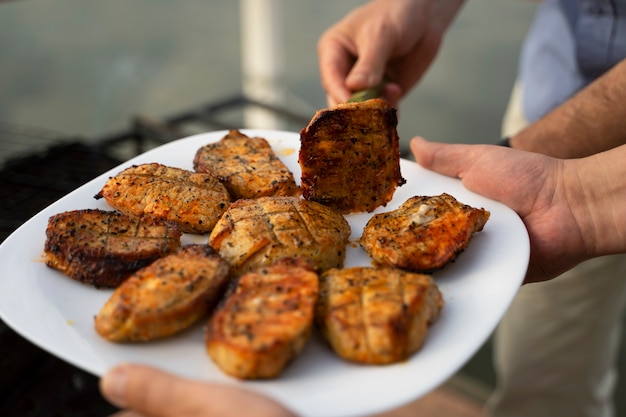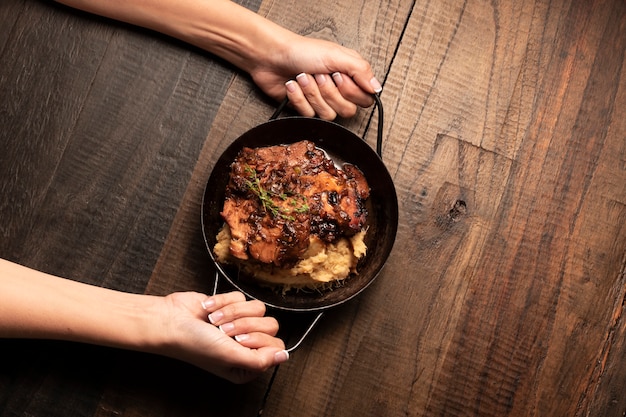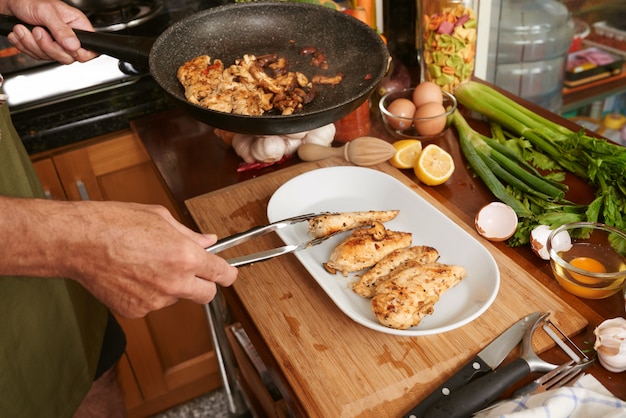There's something truly magical about a perfectly cooked pork roast. The glistening, golden-brown exterior, the succulent meat that melts in your mouth, and that heavenly aroma that fills the entire house – it's a culinary masterpiece that always impresses. Over the years, I've learned a thing or two about achieving this culinary nirvana, and I'm thrilled to share my secrets with you in this comprehensive guide.
Whether you're a seasoned cook or a kitchen novice, this guide will equip you with the knowledge and confidence to roast a pork that will leave your guests (or just yourself!) utterly delighted. Get ready to dive into the world of pork roasting, where we'll cover everything from selecting the perfect cut to mastering the art of seasoning and cooking. We'll explore different cooking methods, address common challenges, and offer creative ways to use up those delicious leftovers.
(Part 1) Choosing the Right Pork Roast

The journey to a delectable pork roast starts with selecting the right cut. You wouldn't attempt to build a house without the right materials, would you? Same goes for cooking a roast. The good news is that there are a few excellent options to choose from, each with its own unique characteristics and best uses. Let's explore the most popular choices:
pork shoulder: The Value Champion
Let's talk pork shoulder – a real workhorse in the kitchen. It's often referred to as “Boston butt,” which is a bit misleading, as it actually comes from the shoulder, not the buttock. It's incredibly versatile and perfect for roasting, slow cooking, or even grilling. I personally love using it for pulled pork sandwiches – the rich flavour and tenderness make it a perfect choice.
The key to pork shoulder is that it's full of flavour, but it does need a bit more time in the oven to become tender. This is where slow cooking really shines. Think about those tender, juicy pulled pork sandwiches – that's the magic of slow cooking a pork shoulder.
pork loin: The Quick and Easy Choice
Now, if you're looking for a roast that cooks quickly and offers a leaner cut of meat, the pork loin is your go-to. It's a tender cut, great for smaller gatherings or if you're craving a quick, satisfying meal. My go-to is a simple rubbed roast with rosemary and garlic. Think juicy slices for a family dinner.
pork tenderloin: The Elegant Option
For something a little fancier, the pork tenderloin is the way to go. It's a lean and delicate cut, best enjoyed in smaller portions. It's perfect for special occasions or when you want to impress. I tend to sear it and then roast it to bring out its natural flavours and keep it nice and moist.
Factors to Consider When Choosing
Here's a quick comparison table to help you make the best choice for your needs:
| Factor | Pork Shoulder | Pork Loin | Pork Tenderloin |
|---|---|---|---|
| Taste | Rich, flavorful, often with a bit of fat | Leaner, delicate flavour | Lean, mild flavor |
| cooking time | Longer cooking time, often slow-cooked | Faster cooking time, suitable for roasting | Quick cooking time, ideal for grilling or roasting |
| Cost | More affordable | More expensive | Most expensive |
| Versatility | Excellent for pulled pork, tacos, and other slow-cooked dishes | Great for roasts, chops, and other quick meals | Best for smaller portions, perfect for special occasions |
(Part 2) Prepping Your Pork Roast

Alright, you've got your perfect pork cut – now let's get ready to make it shine. This is where the magic of prepping really comes into play. Think of it as a chef's secret sauce!
Get the Skin Out
First things first, if your pork roast has a skin, we're going to ditch it. You might be surprised, but the skin on a roast actually can toughen the meat, so it's better to remove it. I usually use a sharp knife to carefully remove it, taking care not to cut into the meat.
Tying Up Loose Ends
Next, let’s talk about tying the roast. This is a bit of an art form, but don't worry, you'll get the hang of it. You can use kitchen twine to tie the roast into a nice, compact shape. This ensures even cooking, keeping those juicy flavours locked in. If you're using a pork loin, it's often good to tie it into a cylinder shape to prevent it from drying out during cooking.
The Importance of Scoring
Now for the fun part - scoring your roast! Take your sharp knife and make evenly spaced cuts across the fat layer of your roast. This helps the fat render beautifully, creating a delicious, crispy crackling on the outside.
Patting It Dry
Finally, pat your roast dry with paper towels. This little step helps the seasoning adhere and prevents the roast from steaming instead of browning. It’s a simple step, but it makes a big difference!
(Part 3) Seasoning Like a Pro

The art of seasoning is where the real magic happens. It’s about creating a flavour symphony that complements the natural taste of the pork. Don’t be afraid to experiment!
A Simple Rub
One of my favourite go-to’s is a simple salt and pepper rub. I use kosher salt, because it really helps to draw out the moisture and enhance the flavour of the meat. And of course, a good grind of black pepper brings in a depth of flavour.
Spice it Up
If you’re feeling adventurous, try incorporating herbs and spices into your rub. I often use a blend of dried rosemary, thyme, and garlic powder. It adds a layer of complexity that really elevates the roast.
A Citrus Twist
For a brighter flavour profile, try a citrus rub. A mixture of grated lemon zest, dried oregano, and a touch of red pepper flakes adds a tangy kick that's absolutely delicious.
Embrace Garlic and Onion
No pork roast is complete without the magic of garlic and onion. I love incorporating them by roasting them alongside the pork for a beautiful caramelized flavour that infuses the entire dish.
Beyond the Basics
Here are a few more creative seasoning ideas to inspire you:
Smoky Rub: Paprika, smoked paprika, chili powder, cumin, and garlic powder.
Sweet and Spicy Rub: Brown sugar, paprika, chili powder, cayenne pepper, and onion powder.
Herby Rub: Rosemary, thyme, sage, oregano, garlic powder, and black pepper.
(Part 4) Choosing the Right Cooking Method
You’ve got your seasoned pork roast, ready to go – now it’s time to choose the cooking method that best suits your needs and your culinary style. There’s a world of options out there!
Roasting in the Oven
The classic, reliable approach: roasting in the oven. It’s a no-fuss method that delivers consistently delicious results. This method is perfect for achieving crispy crackling and beautifully tender meat. Simply preheat your oven, place the roast on a rack in a roasting pan, and let it cook until it reaches the desired internal temperature.
Slow Cooking
For those who prefer a "set it and forget it" approach, slow cooking is a great choice. It’s a wonderfully forgiving method that allows the meat to break down and become exceptionally tender. Simply place your roast in a slow cooker with some liquid and seasoning, and let it cook on low for hours.
The Grill Approach
For a smoky, char-grilled flavour, consider cooking your pork roast on the grill. It’s a great choice for warmer weather, and you can get a really nice crust on the outside. Just be sure to use indirect heat, and keep an eye on the temperature to prevent overcooking.
Important Considerations
Here are some factors to consider when choosing your cooking method:
Time Commitment: If you have time to spare, slow cooking is a fantastic option. If you need a quick meal, roasting or grilling might be more suitable.
Desired Outcome: Do you want a crispy crackling? Roasting is the way to go. Do you crave a smoky flavour? Grilling is perfect.
Equipment: Do you have a slow cooker? If so, that’s your best bet. If not, roasting in the oven is always a reliable option.
(Part 5) Mastering the Internal Temperature
Ah, the holy grail of cooking a pork roast – achieving the perfect internal temperature. This is where a meat thermometer is your best friend.
The Safe Zone
The USDA recommends cooking pork roasts to an internal temperature of 145°F (63°C), measured in the thickest part of the meat. This ensures that the pork is cooked through and safe to eat.
Let It Rest
Once your roast reaches the desired temperature, it's crucial to let it rest for at least 10-15 minutes before carving. This allows the juices to redistribute, ensuring a succulent and tender final product.
Know Your Cuts
Keep in mind that different cuts of pork have slightly different ideal temperatures. For example, a pork shoulder is best cooked to a slightly higher temperature than a pork loin.
Using a Meat Thermometer
Now, here's where a meat thermometer becomes your best friend. It’s a small investment that pays off big time. You can use an instant-read thermometer to check the internal temperature quickly and easily.
(Part 6) The Joy of Leftovers
Let’s be honest, a delicious pork roast often leads to a bounty of leftovers. And that’s a good thing!
Pulled Pork Sandwiches
One of my absolute favourite ways to repurpose leftover roast pork is in a classic pulled pork sandwich. Shred the meat and toss it in a tangy bbq sauce – it’s a guaranteed crowd-pleaser.
Pork Hash
Another delightful way to use up those leftovers is by creating a hearty pork hash. Combine shredded pork with potatoes, onions, and your favourite spices for a comforting and flavorful meal.
Pork Soup
For a warm and comforting meal, transform your leftover pork into a flavourful soup. Add the shredded meat to a broth base along with vegetables and herbs for a delicious and nourishing meal.
Pork Tacos
For a fun and casual meal, use leftover pork to create delicious tacos. Warm up some tortillas and fill them with shredded pork, salsa, and your favourite toppings.
(Part 7) Serving Up Your Masterpiece
You’ve invested time, effort, and love in creating this culinary masterpiece – now it’s time to serve it up in style.
Choose Your Sides
Consider your sides carefully. roast vegetables like potatoes, carrots, or Brussels sprouts complement the pork perfectly. A simple green salad adds a refreshing contrast.
Carving with Confidence
When it comes to carving, a sharp knife is essential. Use a carving fork to hold the roast steady, and cut across the grain for tender slices.
Presentation Matters
A beautiful presentation elevates any dish, and your pork roast is no exception. Arrange the slices on a platter, drizzle with pan juices, and garnish with fresh herbs.
Enjoy the Moment
Finally, relax, take a deep breath, and enjoy your hard work. A perfectly cooked pork roast is a celebration of flavour and a testament to your culinary skills.
(Part 8) FAQs
Let's tackle some common questions about pork roast:
1. What are some tips for keeping my roast moist?
There are a few tricks to help keep your roast nice and juicy.
Firstly, don't overcook it! Make sure you check the internal temperature regularly and pull it out of the oven when it reaches the desired temperature.
Secondly, use a meat thermometer to ensure it’s cooked through. This way, you’ll have juicy, tender meat.
Thirdly, let your roast rest for at least 10-15 minutes before carving. This allows the juices to redistribute, making for a moister and more flavorful roast.
Finally, consider adding a little bit of liquid to the bottom of the roasting pan, like broth or apple juice, to help keep the roast moist.
2. How do I get that crispy crackling on the outside?
A crispy crackling is a real treat! It’s all about the fat layer.
When scoring the roast, ensure that your cuts go through the fat layer, but not into the meat itself. This helps the fat render beautifully, resulting in that delicious crispy crackling.
During cooking, keep a close eye on the roast, and towards the end, increase the oven temperature to a high setting to encourage crispiness.
For an extra crispy crackling, try brushing the roast with a mixture of honey and soy sauce before cooking.
3. Can I freeze a pork roast?
Absolutely! Freezing a pork roast is a great way to extend its shelf life. Simply wrap it tightly in plastic wrap or aluminum foil, then place it in a freezer bag. It can be frozen for up to 3-4 months.
4. What happens if I overcook my roast?
Don’t worry, it’s not the end of the world if you accidentally overcook your roast. While it might be a little bit dryer than you’d prefer, it’s still perfectly safe to eat. Try to shred the meat and use it in a dish like pulled pork sandwiches or a soup, where the dryness won’t be as noticeable.
5. How do I know if my pork is done?
The best way to determine if your pork roast is cooked through is to use a meat thermometer. It’s the most accurate method to ensure that your roast has reached the safe internal temperature. If you don't have a thermometer, a good rule of thumb is to check that the juices run clear, not pink.
6. What if my roast isn't browning nicely?
If your roast isn't browning properly, try increasing the oven temperature slightly or turning it to broil for a few minutes towards the end of cooking. You can also try basting the roast with pan juices or a mixture of butter and oil for a more golden-brown crust.
Final Thoughts
Cooking a juicy, tender pork roast is a culinary journey that rewards you with a delicious meal and a sense of accomplishment. By following these tips and embracing your creativity, you’ll be well on your way to mastering the art of pork roasting. So, go forth, experiment, and enjoy the delicious results!
Everyone is watching

Corn on the Cob: The Ultimate Guide to Perfectly Cooked Ears
Healthy MealsAh, corn on the cob. Just the name evokes images of sunny days, barbecues, and that sweet, juicy flavour that ...

Scallops: The Ultimate Guide to Perfect Cooking
Healthy MealsAh, scallops. Those delicate, sweet, and utterly delicious morsels of the sea. They hold a special place in my...

Spaghetti Squash: The Ultimate Guide to Cooking and Serving
Healthy MealsRemember that time you saw spaghetti squash at the supermarket, looking all bumpy and strange, and thought, "W...

Salmon Cooking Times: Perfect Guide for Every Recipe
Healthy MealsLet me tell you, cooking salmon is an art form. It's all about getting that perfect balance: juicy and tender,...

Ham Cooking Time: How Long to Bake, Smoke, or Boil a Delicious Ham
Healthy MealsAh, ham. It's a classic, isn't it? A real crowd-pleaser, especially around holidays. And when done right, it'...
